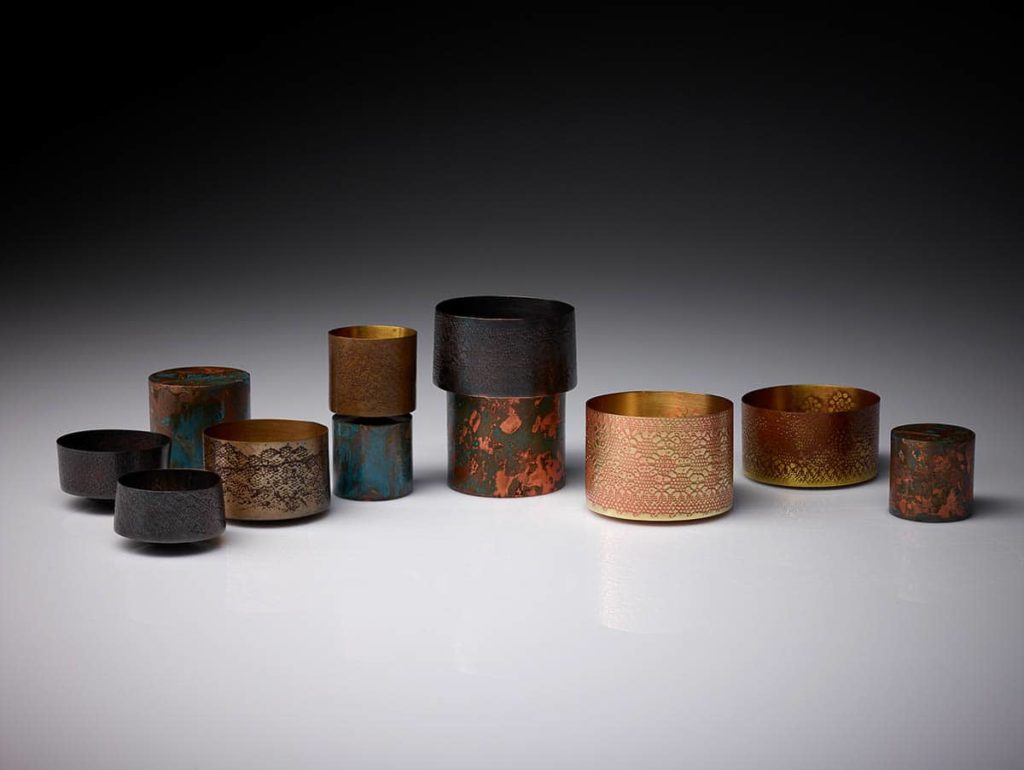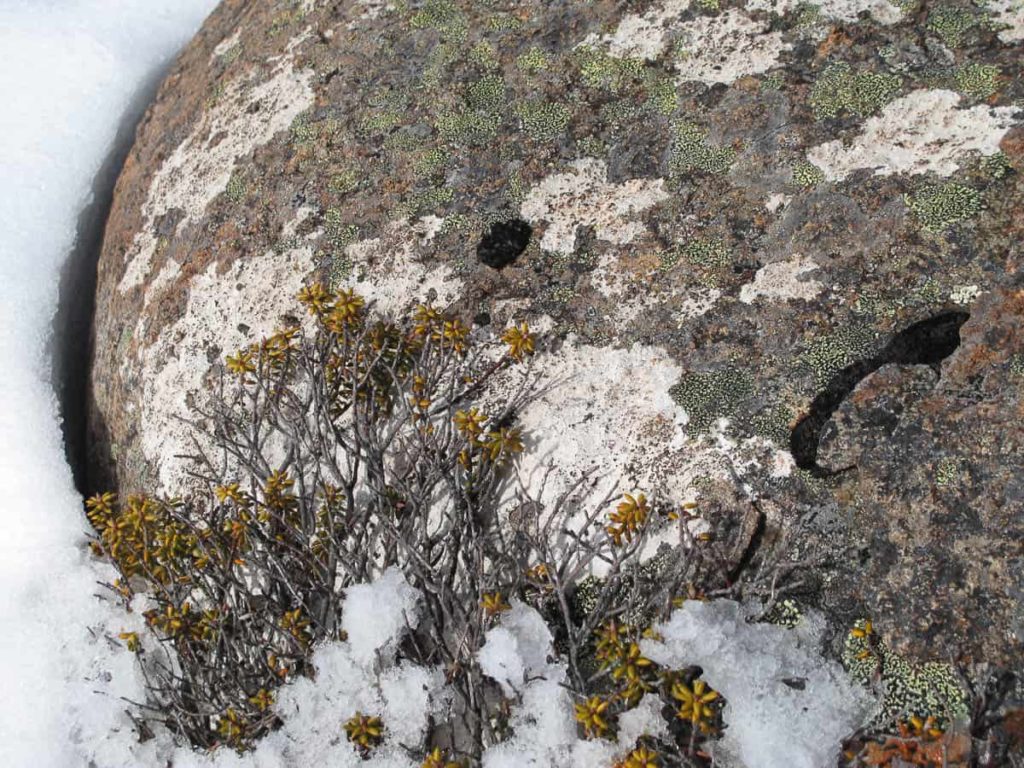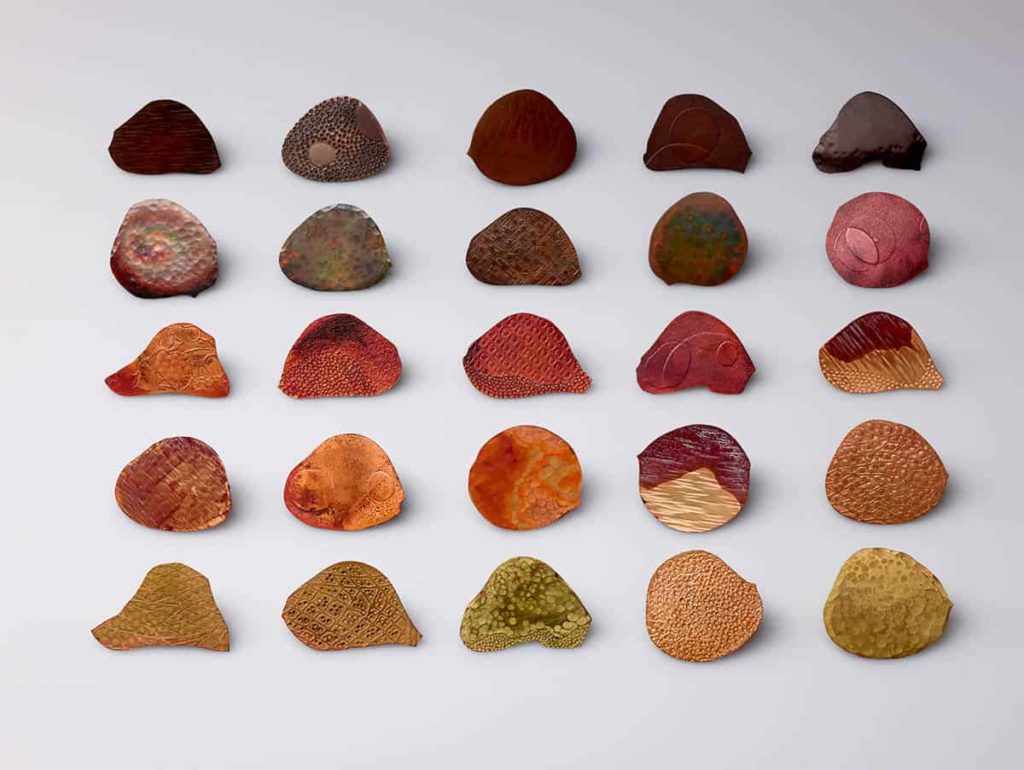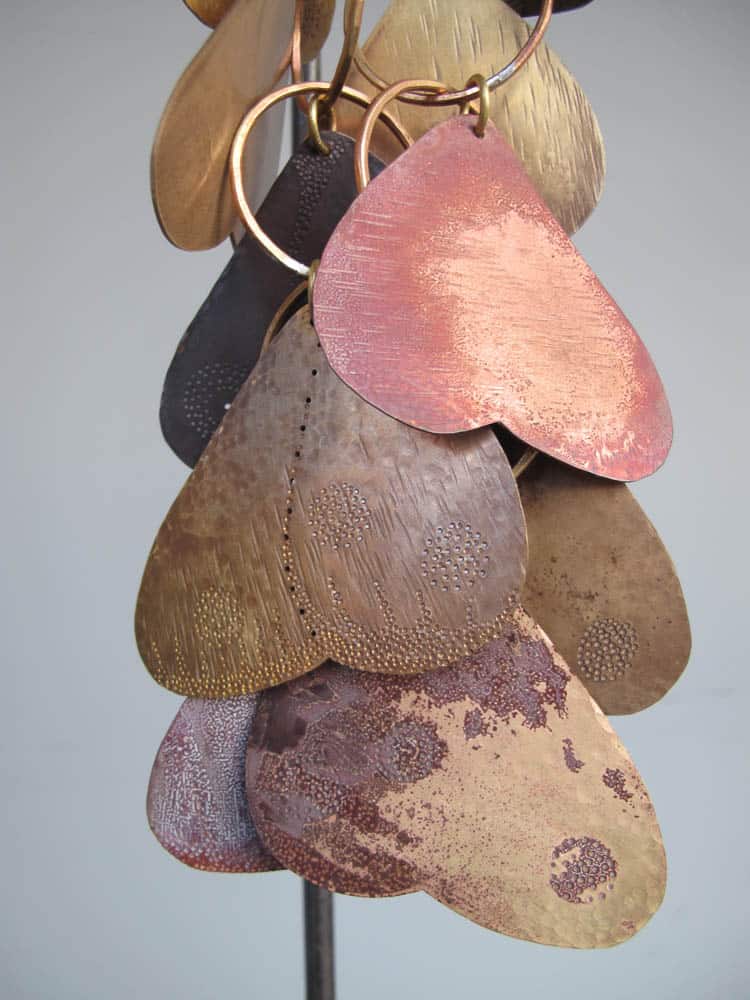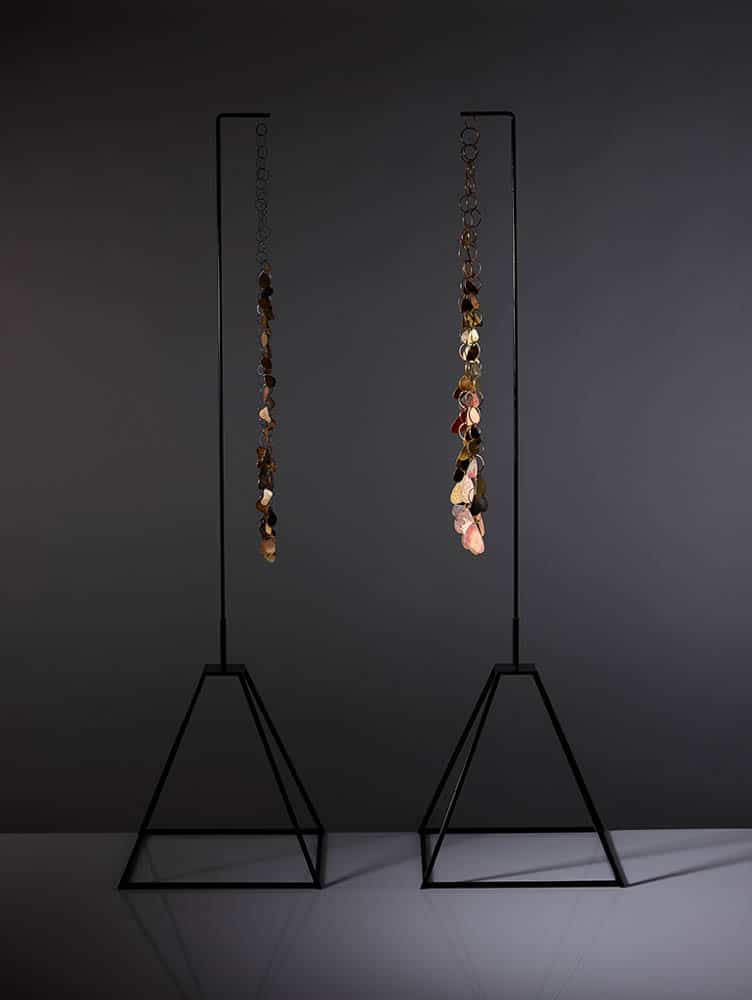- Zoe Veness A Landscape of Our Making 2017 Brass copper Largest vessel 30 x 57 x 57 mm Photo Peter Whyte
- Zoe Veness A Landscape of Our Making with Rose Petal Pins 2017 Brass copper sterling silver Largest vessel 30 x 57 x 57 mm Photo Peter Whyte.
- Zoe Veness kunanyi Mount Wellington 6 2017 Digital print on composite aluminium panel 420 x 594 mm Photo Zoe Veness
- Zoe Veness Rose Petal Pins 2017 Brass or copper and silver Average size 30 x 26 x 10 mm Photo Peter Whyte
- Zoe Veness Butterfly Gathering necklace (detail) 2017 Brass 86 cm long, photo: Zoe Veness
- Zoe Veness Butterfly Gathering and Remnants necklaces on custom made stands 2017 Photo Peter Whyte
Last year I was fortunate to rent a small stone cottage in Hobart that was the ideal setting for the making of new work towards a solo exhibition. The 1850s cottage was one of fifteen that framed a small circular park in Battery Point with clear views of kunanyi/Mount Wellington in the distance. Each day as I left for work I would glance up to see the mountain either shrouded in mist or snow or illuminated by the morning sun. The colonial history of Hobart and the dramatic backdrop of the mountain created plenty of inspiration for the show I titled New Terrain in an Old World which was held at Craft ACT last November.
Maria Kunda expressed it well in her catalogue essay for my exhibition when she wrote “newcomers to Hobart are virtually compelled to go to the mountain’s pinnacle in order to really arrive.” I remember clearly my first encounter of the pinnacle particularly the sense of deep time experienced by the west-facing vista of pink dolerite and alpine vegetation. Over subsequent visits, I documented the details of this landscape through a series of photographs including the lichened rock surfaces and the spiky foliage. The most significant photos were taken during a winter visit last August when I joined hordes of people scrambling to the top to immerse in fresh snow. These photos became pivotal references for the work by highlighting the detail of this ancient landscape. I included six in the show, three from winter and three from summer. They hung in the gallery space opposite each other, a winter scene on one wall and its counter season on the other. I liked how these representations of the majestic mountain, albeit through the tiniest of details, surrounded the central arrangement of free-standing objects, a subtle reminder of the mountain’s omnipotence.
This play with inversions of scale, seen in the close-up details of the mountain as a means to convey deep time, transferred to the making of a long brass necklace titled Butterfly Gathering. Spanning 86 cm in length, the piece was referenced loosely on a tiny butterfly endemic to Tasmania called the Ptunarra Brown (Oreixenica ptunarra). This butterfly is currently threatened due to farming methods and bushfire that has eradicated grasses vital to the butterfly’s survival. I enlarged the wing shapes as a commemorative gesture to highlight the potential loss of the species and along with a second brass necklace titled Remnants, displayed them on custom-made stands like a gateway or signals or signs. I liked the ambiguity of this jewellery-sculpture, part ceremonial, part warning that arose through my ongoing desire to explore new presentation methods for my work.
The city’s colonial history signified by my rental cottage and other heritage buildings throughout the area were constant reminders of Tasmania’s dark past. By the time the cottage was built in the 1850s, the “Black Line” of European soldiers had snaked its way across the island effectively wiping out Tasmania’s first people. I created a series of lapel pins based on the shapes of rose petals that embodied multiple meanings. They were developed in response to the rose gardens that adorned nearly every weatherboard or stone cottage in Battery Point and also had strong associations to kunanyi. In Western cultures, the rose symbol is traditionally associated with love and in this light, worn over the heart, the rose petal pin speaks about love and devotion. In reference to Hobart’s colonial history, the rose is also a reminder of the coloniser. Maria reflects on the complexity of this symbol when she writes, “We can understand roses as symbolic of colonisation—the willful conversion of this place to conform to European standards, and thus read into them a drive for domination over nature. In the colonialising gesture though, we can read nostalgia and trauma, and in the stories of rose cultivations we can also read many acts of hybridisation as migration, acculturation, mourning and adjustment.”
With their textured markings and patination, these rose petal pins were also reminiscent of the weathered surfaces of kunanyi’s dolerite. I displayed some of the pins in circular vessels that I formed from copper and brass with similar references to landscapes and geographical topographies conveyed through patterns imprinted in the surface with sections of lace. In one of the catalogue photos, two vessels contain some of the pins like cupped hands carrying fragments of something precious. Maria writes, “These are quite literal references to the actuality of the place and, on another register, through the language of jewellery, these elemental objects operate as votive pieces.”
Like the pins, some of the vessels were coloured using the heat from my torch. The experience of heat-colouring the metal in my studio in the middle of winter has become a pivotal memory, watching the metal flash under the flame of my torch and the colours change from pink to gold to purple. Most enjoyable was the unpredictability of the final colouring as despite using the same method each time, no outcome was the same. Now, back in Sydney, when I look at the work I think firstly about how this liberating approach defined new terrain in my practice. And then I think about feeling the icy wind on my face while walking home after work along Hobart’s waterfront with snow-capped kunanyi in the distance, Hobart’s enduring witness to time.
With the assistance of an Australia Council Arts Project grant I produced an exhibition catalogue now a poignant reminder of Hobart as a place of creative inspiration. I thank colleagues from the School of Creative Arts at the University of Tasmania who contributed to the catalogue and the realisation of the exhibition display including Dr Maria Kunda, Stuart Houghton and Finley Smith. I also thank Peter Whyte for photographing the work and Yiorgos Zafiriou for his catalogue text. New Terrain in an Old World was exhibited at Craft ACT: Craft and Design Centre from 16 November to 16 December 2017.
Author
 Zoë Veness is a designer-maker with a practice that oscillates between jewellery and sculpture. She makes jewellery-related objects, some that are not necessarily wearable, as a means to explore key interests including body-object relations, systems of material and cultural value, and methods of display and commemoration. She has undergraduate degrees in the fields of dance and design and completed a PhD in practice-led research from Art & Design, University of New South Wales in 2014. From 2016-2018 Zoë was Studio Coordinator of 3D Design at the University of Tasmania’s School of Creative Arts in Hobart. During 2017 she created new work for Remanence for Tasmania’s Ten Days on the Island Festival, The Posterzine Project and Urban-a-wear-ness for the Radiant Pavilion Biennial in Melbourne and New Terrain in an Old World, a solo show at Craft ACT for the Design Canberra Festival. Earlier this year Zoë moved to Sydney to take up an academic position at Art & Design UNSW.
Zoë Veness is a designer-maker with a practice that oscillates between jewellery and sculpture. She makes jewellery-related objects, some that are not necessarily wearable, as a means to explore key interests including body-object relations, systems of material and cultural value, and methods of display and commemoration. She has undergraduate degrees in the fields of dance and design and completed a PhD in practice-led research from Art & Design, University of New South Wales in 2014. From 2016-2018 Zoë was Studio Coordinator of 3D Design at the University of Tasmania’s School of Creative Arts in Hobart. During 2017 she created new work for Remanence for Tasmania’s Ten Days on the Island Festival, The Posterzine Project and Urban-a-wear-ness for the Radiant Pavilion Biennial in Melbourne and New Terrain in an Old World, a solo show at Craft ACT for the Design Canberra Festival. Earlier this year Zoë moved to Sydney to take up an academic position at Art & Design UNSW.
Images copyright © Peter Whyte 2017

